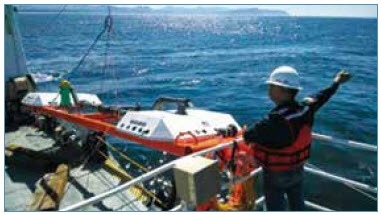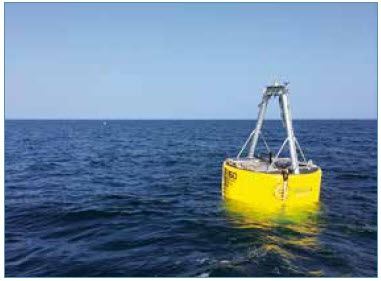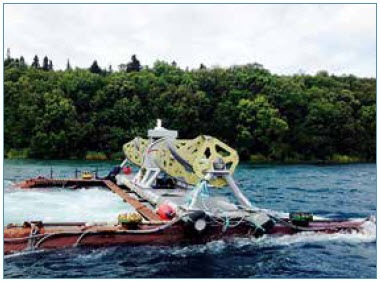UNITED STATES OF AMERICA
TECHNOLOGY DEMONSTRATION
OPERATIONAL PROJECTS IN 2014
|
M3 Wave: M3 Wave’s project explored the commercial viability of the submerged Delos-Reyes Morrow Pressure Device, which uses a unique method of harnessing the up and down motion of waves by inflating and deflating bags–to convert wave energy into electricity. DOE provided funding to advance the technology from the concept definition stage and prove its feasibility with analysis and small-scale experimental testing. The project resulted in estimates for power output and cost of electricity of a full-scale system. NNMREC provided M3 with an analysis of near-shore wave conditions and a detailed system response model while Pacific Energy Ventures and M3 Wave worked with industry experts to estimate full-scale system and operating costs. This project created new tools and techniques for modelling and testing submerged near-shore devices. Following the completion of the DOE-funded portion of the project, M3 Wave tested their device off the coast of Oregon in September 2014. Oscilla Power: With funding from DOE’s SBIR/STTR program, Oscilla Power designed and constructed a modular, scalable WEC device based on reverse magnetostrictive generator technology. This unique technology transforms the energy from changes in tension and strain into electricity, using inexpensive alloys, and has no moving parts. Although this technology is being developed for wave energy, it can be applied to capture energy from any structure that experiences changes in tension and strain. For example, Oscilla has licensed the technology to provide downhole power during drilling for the oil and gas industry. Oscilla tested their TDU2 system off the coast of New Hampshire at Isle of Shoals in Ocean Renewable Power Company (ORPC): ORPC successfully deployed the RivGen Power System in Summer 2014. The RivGen Power System harvests energy from river and tidal currents, generating electricity either with direct power grid connection or in remote communities with isolated power grids. Its core component, the turbine generator unit, utilizes innovative control systems to drive advanced turbines that efficiently provide reliable energy even within highly turbulent flow environments. The deployment validated simulations and successfully demonstrated the “self-deploying/self-retrieving” capabilities of the device. ORPC’s advanced control systems are being developed in collaboration with the University of Washington, Maine Technology Institute and NREL with support from the DOE Water Power Program.
Resolute Marine Energy: The Water Power Program is supporting Resolute Marine Energy to develop an intelligent feedback control algorithm for their next generation device, SurgeWECTM. The control system will be validated in Resolute’s Development Center on a full-scale SurgeWECTM and, upon completion, will be integrated into Resolute’s 720 kW wave power project in Alaska. |
|
Fred Olsen: Fred Olsen’s Lifesaver WEC device will be deployed at WETS early next year with the support of U.S. Navy funding. The Lifesaver features up to five independently operating power take-off units, an all-electric power conversion system, and a patented drive train. Its hull design provides buoyancy and water displacement and enables controlled movements, which reduces the impact of sea forces during more aggressive sea states.
Columbia Power Technologies: Columbia Power Technologies will conduct an open-water demonstration of a utility-scale StingRAY at WETS in 2016. With funding from the Water Power Program, the StingRAY includes a direct drive train, which reduces the number of moving parts, permanent magnet generators, which are an efficient way to generate electricity, and a composite structure, which helps to increase the strength and longevity of the device. The deployment at WETS, supported by the U.S. Navy, will include StingRAY utility-scale design and design certification, performance and efficiency validation and design and testing of the structural components.






